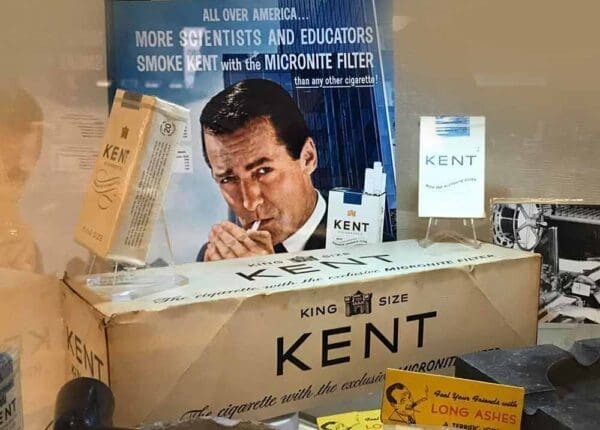01. Asbestos Use in Cigarette Filters
Why Was Asbestos Used in Cigarette Filters?
Lorillard Tobacco Company’s “Kent Micronite” cigarette brand contained crocidolite asbestos from 1952 to 1956. According to Lorillard, crocidolite asbestos was included to provide a finer filtration system. The company advertised better filtration of smoke irritants and a more enjoyable smoking experience.
However, asbestos exposure can lead to numerous health issues, including mesothelioma cancer. Some experts consider crocidolite asbestos the most dangerous type of the mineral. These fibers are fine, sharp and easier to inhale than other types of asbestos. Smoking these cigarettes led to direct inhalation of asbestos fibers into consumers’ lungs.
Asbestos Cigarette Filters History at a Glance
- Other Names: Kent Micronite Cigarettes, Micronite filters
- Years of Manufacture: 1952 – 1956
- Asbestos Use Banned: No
- Noteworthy Brands: Hollingsworth & Vose Company, H&V Specialties, Lorillard Tobacco Company
Hollingsworth & Vose Company manufactured the filters under a subsidiary called H&V Specialties. Hollingsworth & Vose Company also manufactured several other asbestos products.
The filters were attached to the rest of the Kent cigarettes that Lorillard packaged and sold.
Advertisements claimed the filters protected consumer health by filtering out nicotine and tar. The company called the Micronite filters, “the greatest health protection in cigarette history.” However, these claims of better health protection were ironic. Cigarette smoking is a risk factor for many diseases, including mesothelioma. The addition of asbestos to the cigarette filters layered on another level of health risks.
Lorillard officials may have been aware of the dangers before discontinuing the filters in 1956. An April 1954 memo from a research director to company president W.J. Halley said researchers had found “traces of mineral fiber” in the smoke.
Two months later, the president of Hollingsworth & Vose Company wrote about Lorillard officials’ worries about asbestos: “It is Lorillard’s belief that asbestos must be eliminated from the Kent cigarette as soon as possible because of a whispering campaign started by their competitors of the harmful effects of asbestos.”
Despite these concerns, it was still a year and a half before the company discontinued asbestos use in Kent Micronite cigarette filters.
Dangers of Asbestos in Cigarette Filters
Asbestos exposure can lead to mesothelioma and other serious diseases. This exposure can occur when individuals breathe in the asbestos fibers. These fibers can irritate internal tissues, leading to scarring and eventually tumors. Asbestos diseases associated with asbestos exposure include:
Smokers of Kent Micronite cigarettes risked inhaling asbestos fibers each time they smoked.
Although any level of asbestos exposure can be dangerous, consistent and high levels of exposure can be much worse.
In 1995, researchers tested how much asbestos could be released by Kent Micronite cigarettes. The scientists obtained intact, unopened packs of the cigarettes and measured the total level of asbestos per filter.
The researchers also analyzed how many fibers an individual would consume during a year of smoking. They found:
- One filter contained approximately 10 mg of crocidolite asbestos.
- Individuals smoking one pack each day would consume more than 131 million crocidolite fibers per year.
The study authors concluded individuals who smoked these cigarettes should be warned of “possible substantial exposure” to asbestos.
Consumers were not the only people at risk of asbestos exposure from Kent cigarettes. One study examined the presence of cancers in a cohort of 33 men who had worked at a factory that produced cigarette filters. These men developed several types of cancer, including mesothelioma and lung cancer.
The researchers found a higher-than-normal incidence of cancer, including mesothelioma and lung cancer. They concluded the high rates of illness and death among the factory workers could be attributed to heavy asbestos exposure.
02. Cigarette Filters & Asbestos Exposure
Who Is at Risk of Asbestos Exposure From Cigarette Filters?
Asbestos-contaminated cigarettes may have exposed thousands of individuals to the dangerous mineral. This includes consumers who smoked and workers who came into contact with asbestos during manufacturing.
Employees at Hollingsworth & Vose Company plants in Massachusetts may have been exposed during the filter manufacturing process. The cigarette filters were made using a “dry” process that produced large amounts of dust. Workers were present while asbestos fibers, cotton and acetate were mixed, carded and deposited onto crepe paper.
After manufacture, the filters were shipped to Lorillard facilities in New Jersey and Kentucky to be attached to cigarettes, packaged and sold. Workers involved in this process may have also been exposed.
Families of factory workers may have also been at risk of secondhand asbestos exposure.
One woman passed away from mesothelioma after being exposed to the asbestos fibers that stuck to her husband’s work clothing. Her husband and brother worked at the H&V Specialties plants in Massachusetts. They both also passed away from asbestos-related illnesses.
03. Asbestos Lawsuits
Asbestos Lawsuits, Settlements & Other Compensation
Victims of exposure to asbestos-filtered cigarettes may be eligible for mesothelioma compensation. Successful asbestos lawsuits prove negligence on the part of the asbestos company and result in awards for the plaintiffs.
A lawyer or law firm with asbestos experience can help exposure victims determine their best options. Mesothelioma victims wishing to file a lawsuit against Lorillard, Hollingsworth & Vose Company or any other asbestos company should contact a mesothelioma attorney.
Although Lorillard used asbestos for only a short time, it is still named in cases today. Lorillard was purchased by Reynolds American Inc. in 2014. Reynolds American Inc. inherited the liability associated with Lorillard’s asbestos use. Financial statements show the company was a defendant in 46 asbestos filter cases as of year-end 2021.
Since January 2018, Reynolds American Inc. has paid or agreed to pay more than $31 million to settle Kent Micronite filter lawsuits.
Compensation Following Exposure From Asbestos Cigarette Filters
Notable verdicts involving Kent cigarettes include:
- In July 2014, a Los Angeles jury decided a $17.7 million verdict in favor of the wife of an asbestos victim. The man smoked Kent cigarettes and died in 1998 from associated lung cancer. The unanimous decision assigned 17% liability to Lorillard, 50% to the victim himself and 33% to other manufacturers. Lorillard’s portion of the total award amounted to about $3 million.
- In May 2000, a San Francisco jury awarded the family of an asbestos victim $1.04 million. The woman smoked for much of her life, exclusively smoking Kent cigarettes between 1953 and 1979. As a result, in 1996, the woman was diagnosed with malignant abdominal mesothelioma. She died shortly after, and her two children filed a wrongful death lawsuit against Lorillard. The jury decided the case in favor of the victim’s children.
- At least two plant workers in Kentucky have received settlements of more than $700,000 in cases involving Lorillard or one of its predecessors.
Individuals with an asbestos-related disease may be eligible for compensation from Lorillard, Hollingsworth & Vose Company and other asbestos companies. To seek compensation for asbestos diseases, contact an experienced mesothelioma law firm.



